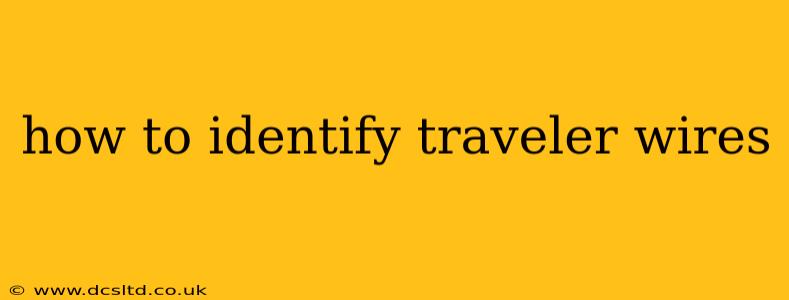Identifying traveler wires can be tricky, especially for those unfamiliar with electrical wiring. These wires, crucial in three-way and four-way switch circuits, carry power between switches to control a single light fixture or appliance from multiple locations. This guide will equip you with the knowledge and techniques to safely and accurately identify traveler wires in your home's electrical system. Always prioritize safety and turn off the power at the breaker box before working with any electrical wiring.
What are Traveler Wires?
Traveler wires are the unsung heroes of multi-location switching. Unlike regular power wires that run directly from a power source to a load (like a light), traveler wires act as messengers, carrying the signal between switches. They don't directly power the light; instead, they complete the circuit, allowing you to control the light from different switches. They are usually found in pairs, with one wire carrying the "hot" signal from one switch to the other and the other wire returning the signal.
How to Identify Traveler Wires: Step-by-Step
Several methods can help you identify traveler wires, each with varying levels of complexity:
1. Using a Non-Contact Voltage Tester
This is the safest method for beginners. A non-contact voltage tester detects the presence of voltage without direct contact.
- Turn off the power: This is paramount! Always switch off the breaker controlling the circuit before commencing any work.
- Locate the wires: Access the switch boxes involved in your multi-location switching.
- Test each wire: Carefully pass the non-contact tester near each wire. The tester will light up or beep if a wire is carrying voltage.
- Identify the travelers: The wires that don't show voltage when the switches are off are most likely the travelers. However, this method only works if you've correctly turned off the breaker controlling the circuit.
Important Note: A non-contact tester doesn't pinpoint specific voltage levels; it simply indicates the presence or absence of voltage.
2. Using a Voltmeter
This method offers greater precision than a non-contact tester.
- Turn off the power: Absolutely crucial!
- Set the multimeter: Configure your multimeter to measure AC voltage.
- Test each wire: Carefully touch the probes of the multimeter to each wire. The voltage readings should be near zero if the power is off correctly.
- Turn on the switches: Flip the switches on and off individually while monitoring the readings. Traveler wires will show voltage fluctuations depending on the switch's position.
Caution: This requires a good understanding of multimeter usage. Incorrect usage can lead to shocks.
3. Tracing Wires (Advanced Technique)
This method requires a deep understanding of electrical wiring and should only be attempted by experienced electricians. It involves tracing wires from one switch box to another and carefully observing their connections.
- Turn off the power: Essential safety measure.
- Follow the wires: Physically trace the path of each wire to understand its connection points.
- Observe the connections: Carefully analyze how the wires are connected within the switch boxes.
- Identify the common wire: The wire connected to the switch that doesn't change state when another switch is flipped is the common wire. The remaining wires are travelers.
Identifying Traveler Wires: Common Mistakes to Avoid
- Not turning off the power: This is the most significant mistake, potentially leading to serious injury or death. Always double-check the breaker.
- Incorrect multimeter usage: Misusing a voltmeter can result in incorrect readings and potentially dangerous situations.
- Misinterpreting test results: Accurately interpreting the readings from a non-contact tester or voltmeter is essential.
What if I Can't Identify the Traveler Wires?
If you're uncertain or uncomfortable working with electrical wiring, it's best to consult a qualified electrician. They have the experience and tools to safely identify the wires and complete any necessary work.
Frequently Asked Questions
How many traveler wires are in a three-way switch circuit?
A three-way switch circuit typically uses two traveler wires.
How many traveler wires are in a four-way switch circuit?
A four-way switch circuit typically uses two or more traveler wires. The exact number depends on the circuit's complexity.
Can I use a wire nut to connect traveler wires?
Yes, but only after correctly identifying the wires and ensuring the power is off. Use appropriately sized wire nuts for the wire gauge.
Remember: Safety is paramount when working with electrical systems. If you're not comfortable with any of these methods, call a qualified electrician. This article is for informational purposes only and does not constitute professional electrical advice.
